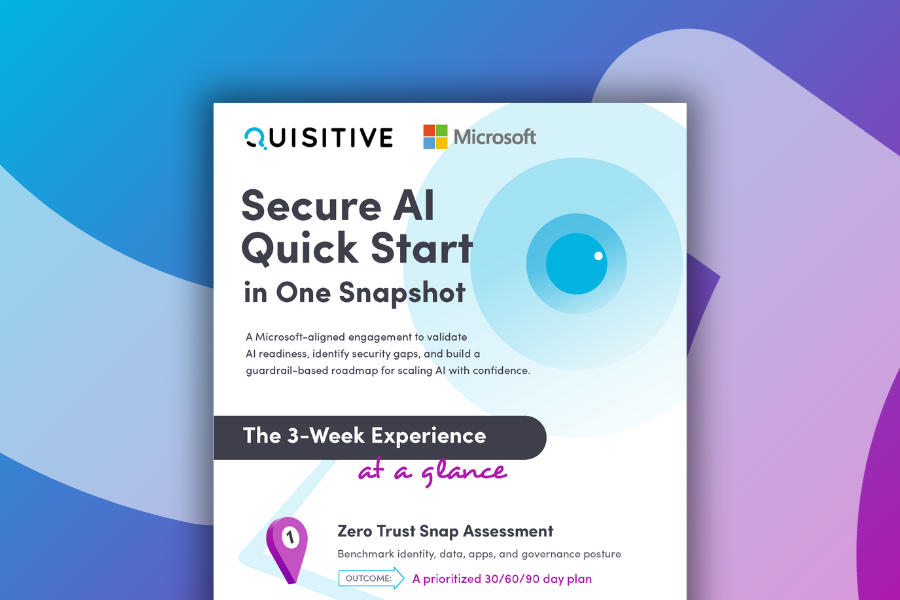Introduction
Earlier this month, Microsoft issued urgent security updates addressing three serious Microsoft Office RCE vulnerabilities affecting its Office suite. Tracking identifiers CVE-2025-53731, CVE-2025-53740, and CVE-2025-53730, these bugs are particularly alarming. They can be triggered when a user merely previews a malicious document — no intentional opening required. Released under Patch Tuesday updates on August 12, 2025, Microsoft classified the first two as “Critical” (CVSS 8.4) and the third as “Important” (CVSS 7.8).
As a security evangelist and advisor at Quisitive, it’s imperative to raise awareness among our client base:
“the threat is real, the risk is high, and the time to act was yesterday”
Vulnerability Breakdown
CVE-2025-53731 & CVE-2025-53740 (Both Critical, CVSS 8.4)
These are use-after-free memory corruption vulnerabilities (CWE-416) that enable remote code execution. Attackers can craft a malicious Office document (Word, Excel, PowerPoint, etc.). When rendered in the Preview Pane, the bug triggers automatically. That means no user interaction and no “enable content” warning is required. A system can be compromised as soon as the file appears in the user’s preview view.
“These flaws span Office 2016, 2019, LTSC 2021 and 2024, Microsoft 365 Apps for Enterprise, and Office for Mac LTSC 2021 and 2024.”
Based on the latest information, Microsoft 365 Apps for Enterprise (commonly referred to as M365) and Office 365 / Office 365 ProPlus are affected by these Microsoft Office RCE vulnerabilities, particularly CVE-2025-53731 and CVE-2025-53740.
- Microsoft 365 Apps for Enterprise (formerly Office 365 ProPlus) is explicitly listed as affected by CVE-2025-53731. These remote code execution (RCE) vulnerabilities apply to that platform.
- Office 365 (in its modern subscription form) is also included under Microsoft 365 Apps schemes. It therefore shares the same exposure risk.
CVE-2025-53730 (Important, CVSS 7.8)
This vulnerability impacts Microsoft Office Visio. It also stems from a use-after-free error. Though rated as “Important,” it still poses serious risk, especially in environments where Visio files are regularly exchanged. A crafted Visio document, when opened, could allow an attacker to run arbitrary code on the targeted system without additional user consent.
Why This Matters – A LOT
- Ease of exploitation: Users don’t need to explicitly open a malicious file. Previewing an email attachment or browsing a shared folder with auto-preview enabled is enough to trigger exploitation.
- Broad exposure: These Microsoft Office vulnerabilities affect both Windows and Mac installs across many versions. Widely deployed enterprise editions mean millions of endpoints are at risk.
- High-impact outcomes: A successful exploit can lead to full system compromise, lateral movement within networks, data theft, ransomware deployment, or persistent backdoors.
- Threat landscape readiness: Attackers gravitate toward low-barrier exploits. The lack of necessary user action, combined with widespread applicability, makes these vulnerabilities prime targets for automated or spear-phishing attacks.
Strongly Recommended and Immediate Actions
- Deploy Patches Immediately
Update all affected Office versions — Windows, Mac, LTSC, and Microsoft 365 Apps — without delay. Microsoft released patches on August 12, 2025 to address these vulnerabilities. - Disable Preview Pane or Implement Safe Rendering
If patching is not immediately possible, disable automatic preview in email clients or file explorers. Alternatively, use sandboxed or virtualised environments to view unknown documents. - Harden Email & File Sharing Policies
Train users to treat unsolicited attachments with caution, even if previews look legitimate. Use email gateway scanning and block high-risk file types or emails from untrusted sources. - Layered Defense Strategy
Use endpoint protection platforms with behavioural detection to watch for suspicious code execution from Office applications. Apply network segmentation to prevent lateral movement and enforce least-privilege policies to limit damage. - Continuous Threat Monitoring & Response
Deploy monitoring and MDR solutions to track anomalous activity. Run regular threat hunts for indicators of compromise (IoCs). Isolate or remediate affected machines quickly.
Consequences of Inaction
Failing to act quickly gives adversaries a backdoor into customer environments:
- Rapid compromise: Threat actors can ship weaponised documents through email or shared drives. A single preview could lead to full domain access.
- Escalating breach impact: Once inside, attackers can deploy ransomware, exfiltrate sensitive corporate or client data, or launch broader campaigns. These often go undetected if preview hits are ignored.
- Reputational damage: Data breaches or ransomware incidents erode trust in security posture, especially when the cause is a known, patchable vulnerability.
- Regulatory repercussions: Depending on industry and jurisdiction, failure to patch critical vulnerabilities may violate compliance frameworks or expose organizations to fines.
- Increased operational disruption: Reacting after a breach (containment, forensics, rebuilds) costs 5–10× more in time and resources compared to proactive patching.
Conclusion and Next Steps
These Microsoft Office RCE vulnerabilities are not theoretical. They are real, pressing, and dangerous. With minimal interaction needed to exploit, bad actors can gain footholds easily. At Quisitive, we strongly urge all clients and prospects to treat patch deployment, preview pane hardening, and layered security as top priorities.
How Quisitive Can Help
- Spyglass® Security & Compliance Program: Continuous security improvement with MDR, compliance mapping, and vulnerability remediation to protect against Office exploit vectors.
- Azure Management Services (AMS): Proactive cloud monitoring, cost/security optimisation, and automated patch governance across your Microsoft 365 and Azure environments.
- Vulnerability & Remediation Management Services (VRM): Advanced automation and expertise to identify, execute, remediate, and document vulnerability, patch, and hardening practices within your Microsoft 365 and Azure environments.
- Managed AI Service: Integrated AI-powered monitoring, anomaly detection, and governance to reduce human error and improve defense readiness.
- Staff Augmentation Services: In cases like this, you may just need experts to step in. Contact us immediately if you need hands-on help with this or other tactical needs.
If your organization needs support validating patch deployment, strengthening Office and Microsoft 365 defenses, or building a proactive incident response plan, connect with Quisitive’s security team today. We’ll help you close this exposure before attackers exploit it.
Until next time,
Ed

;)



